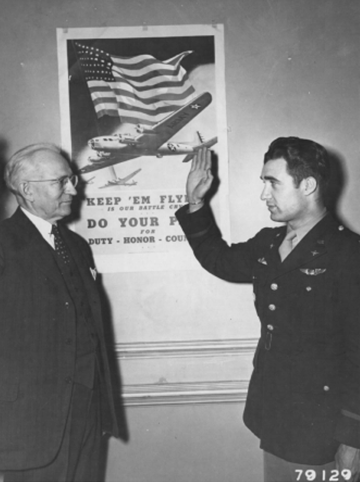Military Naturalization During WWII

After the United States entered World War II, Congress acted to provide for the expedited naturalization of aliens serving honorably in the U.S. Armed Forces.
The Second War Powers Act of 1942 (56 Stat. 182, 186) exempted alien service members from naturalization requirements related to age, race, residence, any educational tests, fees, filing a declaration of intention, and enemy alien status. Later, a 1944 statute (58 Stat. 885) also eliminated the requirement for proof of lawful entry to the U.S.
Alien service members who wished to naturalize still needed to show that they had served honorably, had good moral character, were attached to the principals of the Constitution, and had a favorable disposition toward the good order and happiness of the United States. No member of the military was forced to naturalize and service members did not “automatically” gain citizenship upon joining the Armed Forces. To become a citizen, a naturalizing service member needed to file a petition for naturalization and swear the required Oath of Allegiance.
During the War the Immigration and Naturalization Service (INS) oversaw the campaign to naturalize members of U.S. Armed Forces. Stateside, the INS worked with the military to identify alien soldiers who wished to naturalize, helped soldiers complete the required petition, and organized swearing ceremonies. In many cases INS officials traveled to military camps to process large groups of soldier petitions. Because petitioners needed to swear the Oath of Allegiance in open court, a naturalization judge would then open a session of court at the camp and swear in the soldiers onsite.
The Second War Powers Act of 1942 also authorized the first overseas naturalizations in the nation’s history. Under its provisions, the Commissioner of Immigration and Naturalization could authorize designated representatives to naturalize members of the Armed Forces serving outside of the U.S. This eliminated the need for soldiers stationed overseas to swear the oath in open court and, for the first time, allowed administrative officials to perform naturalizations. The Commissioner designated representatives from the Department of State and U.S. District Attorney’s Office, but INS officials conducted the majority of overseas naturalizations.
On December 4, 1942, INS Assistant Commissioner Thomas B. Shoemaker (who served as INS’s first designated representative for overseas naturalization) naturalized James A. Finnell Hoey in the Panama Canal Zone, making Hoey the first person to receive U.S. citizenship abroad. Over the next year Shoemaker went on to naturalize 289 service members overseas.
Over the course of the war, Henry B. Hazard, INS Director of Research and Educational Services, performed more overseas naturalizations than any other INS official—by a wide margin. Between February, 1943 and early 1945, Hazard traveled nearly 100,000 miles and visited six continents in order to naturalize 6,574 service members. This made him responsible for the vast majority of INS’s overseas naturalization (INS agency officials performed a total of 7,178 overseas naturalizations) and nearly half of all overseas naturalizations during WWII (all designated government officials performed a total of13,587 overseas naturalizations)1. On April 3, 1946, the War Department recognized Hazard’s wartime service by awarding him the Medal of Freedom.
Hazard chronicled his wartime experiences in a series of articles for the Immigration and Naturalization Service periodical Monthly Review, including summaries of his earliest overseas naturalization trips , his work in the Pacific Theater , and a postwar reflection . In October 1948, the Monthly Review also published INS Commissioner Watson B. Miller’s summary report on the Foreign Born in the U.S. military during WWII .
*Full text issues of the Immigration and Naturalization Service Monthly Review are available through the USCIS History Library’s online catalog.
1 Overseas naturalizations for members of the U.S. armed forces continued in 1946 and 1947. Including naturalizations performed during those years brings the total to 21,011. In calculating overseas naturalization performed during WWII INS usually used the total from 1942-1945 (13,587).
| << Back to World War II |
|
